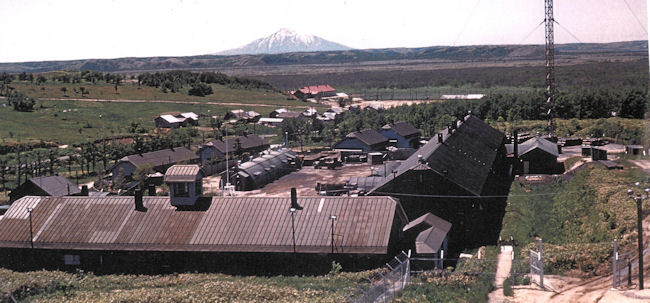Special Report:
REFLECTIONS OF THE 254th USASA DETACHMENT
MAKUBETSU, HOKKAIDO, JAPAN
by Bill Reich
Regrettably Bill passed away April 2012

ASA Chitose Association
Special Report:
REFLECTIONS
OF THE 254th USASA DETACHMENT
MAKUBETSU, HOKKAIDO, JAPAN
by Bill Reich
Regrettably Bill passed away April
2012
REFLECTIONS OF THE 254TH USASA DETACHMENT MAKUBETSU, HOKKAIDO, JAPAN
1. The 254th USASA Detachment was established during the Korean War, as early as 1952. This US Army Unit performed Security duties in support of the Governments of Japan and the United States in accordance with the US-Japan Security Treaty.
2. The Unit was located on 16 acres of land on a hill overlooking the village of Makubetsu. It was the same location that had been used by the Imperial Japanese Navy as a Signal Station prior to World War II. Personnel often traveled temporarily to Nemuro and Soya Omisaki for special assignments. The military work force consisted of 50 permanent military, although frequent visitors came from Washington, DC, Hawaii and other parts of Japan.
3. The 254th Detachment received its mission orders and direction from the Army at Chitose, Hokkaido and Camp Zama in Kanagawa Prefecture. Each of these Headquarters Activities frequently sent advisors, Inspectors and subject matter experts to assist the Detachment.
4. This small unit had an immediate economic impact on the surrounding villages and towns. In addition to purchases of goods and services, the 254th Detachment also employed many local residents to assist and support the on-going activities. These industrious and loyal employees lived in the surrounding towns to include Makubetsu, Omisaki and Wakkanai. Some examples of our Japanese employees and their work:
Security Guards
Equipment mechanics for vehicles and power generation
Radio Repair
Dining Room (cooks and waitresses)
House Keeping
Supply Accountability and issue
Craft Shop Instructors
Laundry Attendants
Barber shop
Vehicle Drivers
5. When not working, the Soldiers spent time in local restaurants, bars, movie theaters, and used public transportation (taxi, bus, train) while meeting Japanese people who lived and worked in the area. There was also time for sports such as baseball, basketball, skiing and fishing. Many close friendships were established between the Soldiers and their Japanese hosts.
6. The American Soldier has had a love affair with Children all over the world for decades. The members of the 254th Detachment contributed to and carried on this tradition. Some examples:
a. Annual Christmas Party. Children living nearby the unit were invited to the Annual Christmas party which always included a visit from “Santa Claus”. Each child received a gift and enjoyed cookies, candy and drinks. Later, family members living in the USA sent clothing and school materials which were distributed to the children.
b. A few of the Soldiers taught Conversational English at the Makubetsu School, told stories and generally entertained the students. During these visits to the school, the Soldiers also assisted by repairing and refurbishing school furniture.
c. The 254th Soldiers installed basket ball courts at both Makubetsu and Soya Point Schools, provided equipment and taught the game to the students. Soon the students were victorious over the Instructors !!
7. Although thousands of miles from home, missing their families and friends, many of the young Soldiers were saddened to leave Makubetsu and their beloved Japanese friends and neighbors.
The following poem was published in the Chitose Army Newspaper in August 1959:Sayonara To Makubetsu
With deep pride and humility we wish to say
Our assignment here was effective in every way
Our Detachment consisted of soldiers so true and rare
Earnest, loyal, quality beyond compare.
We far from home in a foreign land did serve and live
Our duties required our best we willingly give
Our hearts to maintain the American’s Creed
To preserve our Nation’s way by word and deed.
Makubetsu your beauty, customs, culture – do preserve
We wish you a happy future – you rightfully deserve
The 254th expresses fond regards unanimous
To North Hokkaido – Sayonara and arigato gozaimasu.
8. The 254th USASA Detachment was closed on June 30, 1959.Photos can be found at Makubetsu and Makubetsu2
SOURCES: Chitose Confidential, August 1, 1959
Brochure, 254th, Sayonara Makubetsu, June 30, 1959